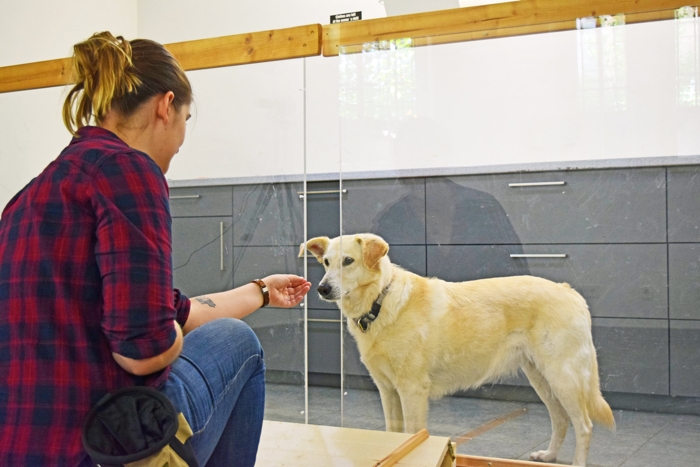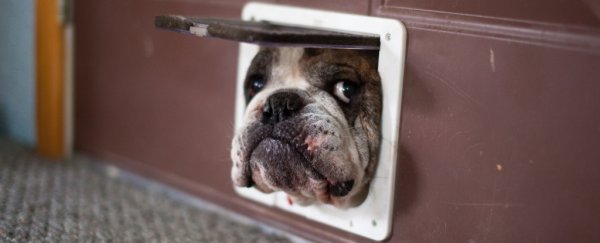Your dog sees you, there's no doubt about that. These beautiful animals are ever watchful, ever devoted to us.
But despite their loving (and food-obsessed) gaze, just how keenly can they identify what we do? Can they discern the meaning and intention behind our actions?
Perhaps they can, at least to some extent, according to new research, which found that dogs were able to correctly distinguish between intentional and unintentional acts on the part of humans.
"The dogs in our study clearly behaved differently depending on whether the actions of a human experimenter were intentional or unintentional," says developmental psychology researcher Britta Schünemann from the University of Göttingen in Germany.
"This suggests that dogs may indeed be able to identify humans' intention-in-action."
 The partition experiment. (Josepha Erlacher)
The partition experiment. (Josepha Erlacher)
In experiments with more than 50 dogs, researchers set up a test to probe whether dogs could tell the difference between human intention and lack of intention.
Making use of an established system called the 'Unwilling vs. Unable' paradigm, a researcher would sit on one side of a transparent partition, with a dog subject on the other.
At the beginning of the experiment, a narrow gap in the middle of the partition enabled the researcher to feed the dog food rewards, which was done a number of times.
After this, the real test began: The food rewards were still shown to the dogs but were then not given to them in one of three different ways.
"In the unwilling-condition, the experimenter suddenly withdrew the reward from the dog with an intentional movement," the researchers explain in their study, with the unwilling-condition signifying the experimenter intentionally withholding the treat from the animal.
By contrast, two other processes reflected instances where the researcher showed an intention to feed the dog but wasn't able to do so.
"In the unable-clumsy condition, the experimenter pretended to try to administer the reward, but the reward 'accidentally' fell out of her hand before she could pass it through the gap," the researchers write.
"Similarly, in the unable-blocked condition, she tried to administer the reward but was unable to pass it through the gap because it was blocked."
In every scenario, the poor dog failed to get the food reward, but the point was trying to see if the dog acted differently depending on the nature of the failure – could the dog recognize the intention to feed and distinguish it from no intention?
"If dogs are indeed able to ascribe intention-in-action to humans, we would expect them to show different reactions in the unwilling condition compared to the two unable conditions," says senior researcher and animal cognition scientist Juliane Bräuer from the Max Planck Institute for the Science of Human History.
"As it turns out, this is exactly what we observed."
Before the experiment began, dogs had been familiarized with the lab setting and shown that they could in fact walk around the transparent pane to reach the experimenter.
The researchers knew that dogs might ultimately realize it would be easier to obtain the treat if they just walked around the partition to get to the food source.
But the team predicted that dogs who had been 'intentionally' denied the treats would wait longer before attempting this, on the basis they might be less likely to receive the reward anyway.
Alternatively, dogs who merely had the bad luck of having a clumsy or blocked feeding attempt might more readily approach the researcher, having no reason to think they wouldn't receive the treat.
Ultimately, the researchers' predictions about waiting times were borne out, suggesting the dogs on some level were distinguishing intent from lack of intent.
Other dog behaviors in the experiment also supported this view, such as dogs being more likely to sit or lie down on the ground (interpreted as calming signals) when they thought the food was being intentionally withheld.
"To defuse the situation, they might have employed sitting and lying down to appease the experimenter," the researchers write.
"Another possibility is that the withholding of the reward had an activating effect and the dogs thought that some form of learned action might convince the unwilling experimenter to supply the reward."
The findings are reported in Scientific Reports.
